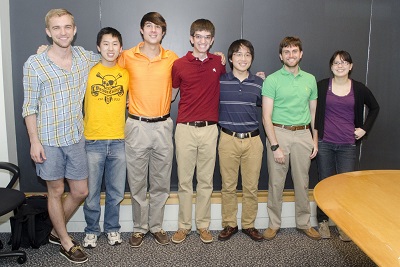Team:Yale
From 2013.igem.org
| (37 intermediate revisions not shown) | |||
| Line 3: | Line 3: | ||
{|align="justify" | {|align="justify" | ||
| | | | ||
| - | '' | + | ==Engineering a factory for plastics in ''E. coli''== |
| - | |[[Image:Team. | + | {| |
| - | + | |[[Image:Team.jpg|right|frame]] | |
| - | + | <html> | |
| - | + | <p style="text-align:justify"> | |
| - | + | Synthetic biology will allow firms to produce industrially important compounds more cheaply and sustainably by leveraging the efficiency of naturally-occurring and artificially-enhanced biochemical pathways. We take the first step in realizing this goal for a widely used plastic, poly(lactic acid), or PLA, by engineering a strain of <i>E. coli</i> for its synthesis. | |
| + | </p> | ||
| + | <p> </p> | ||
| + | <p style="text-align:justify"> | ||
| + | We chose PLA for its particularly useful combination of material properties:<br> | ||
| + | <ul style="text-align:justify"> | ||
| + | <li>It is <b>biodegradable</b>, having a typical lifetime of about 6 months to 2 years until microorganisms break it down into water and carbon dioxide.</li> | ||
| + | <li>It is <b>biocompatible</b>, degrading throughout the entire plastic instead of starting with the outermost layer, allowing the body’s immune response to break down the pieces before it has the time to overreact and damage surrounding tissues.</li> | ||
| + | <li>It is <b>bioabsorbable</b>, allowing it to be resorbed into the body for applications such as spinal implants, slowly transferring the load to the body and allowing the bone to heal in a physically supportive environment.</li> | ||
| + | <li>It is <b>thermoplastic</b>, allowing it to be extruded in filament form and reshaped, often for use in a three-dimensional (3-D) printer.</li> | ||
| + | </ul> | ||
| + | </p> | ||
| + | <p> </p> | ||
| + | <p style="text-align:justify"> | ||
| + | Unfortunately, conventional methods of synthesizing PLA chemically are quite expensive: one gram of pure PLA costs around $90. Moreover, even though it is mostly manufactured from corn, the processing and purifying steps use many chemicals that are environmentally unfriendly. Recently, researchers have genetically engineered <i>E. coli</i> to produce PLA, but at low yields and at insufficiently long chain lengths for commercial use. We propose using multiplex automated genome engineering (MAGE) to improve both the yield and chain length of biosynthesized PLA. MAGE is recombineering on steroids: it takes advantage of the λ Red recombination proteins to increase the efficiency of mutation rate. Instead of laboriously targeting sites one-by-one, many areas of the genome are targeted in parallel. By repeating the procedure numerous times, an incredible amount of diversity can be created in a relatively short amount of time, and from that diversity strains displaying increased product yield can be selected. | ||
| + | </p> | ||
| + | </html> | ||
|} | |} | ||
Latest revision as of 00:28, 19 September 2013
Engineering a factory for plastics in E. coli
|
 "
"

